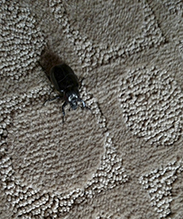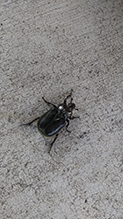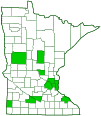hermit flower beetle
(Osmoderma eremicola)
Conservation • Description • Habitat • Ecology • Distribution • Taxonomy
|
|
||||||||||||||
Description |
Hermit flower beetle is a large, fairy common, scarab beetle that resembles a May beetle or June beetle. It occurs in the eastern United States from Maine and Minnesota south to South Carolina and Kansas and in adjacent Canadian provinces. It is found from May to August in rotten logs and tree holes in woodlands and orchards. The adult is robust, flat, 13 ⁄16″ to 1¼″ (21 to 32 mm) long, dark brown, and shiny. There is a deep excavation on the head between the eyes. The exoskeletal plate covering the thorax (pronotum) is covered with deep pits (punctures) and has a deep excavation at the front. The triangular plate between the wing bases (scutellum) usually does not have punctures in the middle and on the sides. The hardened wing covers (elytra) are smooth, not wrinkled. They have rows of fine punctures and scattered smaller punctures, the latter becoming more dense at the sides. The abdomen is densely covered with short brown hairs that poke out from under the elytra. The larvae are white and large, up to 2 ″ long. |
Size |
Total length: 13 ⁄16″ to 1¼″ (21 to 32 mm) |
Similar Species |
Rough hermit beetle (Osmoderma scabra) is smaller, no more than 1″ long. As the common name suggests, the elytra are wrinkled, not smooth. |
Habitat |
Woodlands |
Ecology |
Season |
July through early September |
Behavior |
Hermit flower beetle is active at night and will occasionally come to lights. It hides during the day in a bark crevice near the base of a hardwood tree. When disturbed it exudes a strong leathery odor. |
Life Cycle |
|
Larva Food |
Decaying wood in the trunks and branches of old hardwood trees |
Adult Food |
Sap of hardwood trees |
Distribution |
||
|
Sources |
|
| 7/19/2024 | ||
Occurrence |
||
Fairly common |
||
Taxonomy |
|
Order |
Coleoptera (Beetles) |
Suborder |
Polyphaga (Water, Rove, Scarab, Long-horned, Leaf, and Snout Beetles) |
Infraorder |
Scarabaeiformia |
Superfamily |
Scarabaeoidea (Scarabs, Stag Beetles, and Allies) |
Family |
Scarabaeidae (scarabs) |
Subfamily |
Cetoniinae (fruit and flower chafers) |
Tribe |
Osmodermatini (hermit beetles) |
Genus |
Osmoderma (typical hermit beetles) |
The genus name Osmoderma means “smelly skin”. Adults exude a leathery odor when disturbed. |
|
Subordinate Taxa |
|
|
|
Synonyms |
|
Cetonia eremicola |
|
Common Names |
|
hermit flower beetle |
|
Glossary
Elytra
The hardened or leathery forewings of beetles used to protect the fragile hindwings, which are used for flying. Singular: elytron.
Pronotum
The exoskeletal plate on the upper side of the first segment of the thorax of an insect.
Scutellum
The exoskeletal plate covering the rearward (posterior) part of the middle segment of the thorax in some insects. In Coleoptera, Hemiptera, and Homoptera, the dorsal, often triangular plate behind the pronotum and between the bases of the front wings. In Diptera, the exoskeletal plate between the abdomen and the thorax.
Tarsus
On insects, the last two to five subdivisions of the leg, attached to the tibia; the foot. On spiders, the last segment of the leg. Plural: tarsi.
Visitor Photos |
||
Share your photo of this insect. |
||
This button not working for you? |
||
Norm & Peg Dibble |
||
Huge beetle in my living room!! I am grossed out!!! I sat down in our living room a while ago to brush my cat and saw this huge beetle crawling out from under our coffee table!! So I put her down quickly and took photos, first things first. Then managed to put a Dixie paper cup over it and slowly slide an index card under the cup, like we often do with some bees/moths to carry them outside where they belong. I was worried that my cat would try to paw it but luckily she paid more attention to me getting the cup etc. I just can't figure out how this got inside. We have a fireplace and under our living room is a crawl space, but we rarely have bug problems, and they are small if any. Could it really have flown in through the door with us? I can't recall ever running into one in our 40 years of owning a home and gardening. It is black and bigger than a June bug. I took some photos from under the table and some on our sidewalk after letting it go. Our carpet has a pattern of 3" squares with circles in them. I'm sure glad it didn't try to fly! I'm very afraid of spiders, by the way. |
 |
|
 |
||
MinnesotaSeasons.com Photos |
||
|
||
|
||

Slideshows |
|

Visitor Videos |
||
Share your video of this insect. |
||
This button not working for you? |
||
|
Other Videos |
||
Huge Beetle! Scarab (Osmoderma Eremicola) |
About
Published on Jul 22, 2017 Found this bug while walking in Toronto, Canada, and it was one of the largest I've ever seen around here. Identified it as a scarab (osmoderma eremicola)! |
Osmoderma eremicola |
About
Published on Jul 12, 2008 There was a lack of videos about Osmoderma on youtube. No, it's not the most pertinent thing EVER about this insect, but please, don't hate me for that. :) Specimen caught July 9 in Ste-Julie, Québec, Canada |

Visitor Sightings |
||
Report a sighting of this insect. |
||
This button not working for you? |
||
Wendy Hell |
Location: Fargo, ND Just cut down a flowering crab tree that was split in a storm. Found three of these insects among the shavings. I’m not sure if this is the type of beetle this is but that is what Google identified it as. |
|
J. Mcgie |
Location: Minneapolis, MN 55418 |
MinnesotaSeasons.com Sightings |
||
|

Created: 7/27/2019 Last Updated: © MinnesotaSeasons.com. All rights reserved. |

